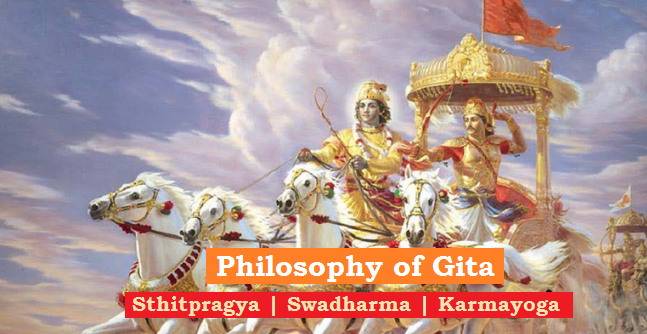
| Bhagavat Gita= Bhagavad: Lord; Gita: song |
| Meaning: Song of the Lord |
Bhagavat Gita is the literature written in poetic form is a part of the epic Mahabharata (under Bhishma Parva) complied around 200 BC. It is set in a narrative framework of a dialogue between Pandava Prince Arjuna and his guide and charioteer Krishna in the Battle of Kurukshetra.
At the start of the Dharma Yuddha (Righteous War) between Pandavas and Kauravas, Arjuna is filled with moral dilemma and despair about the violence and death the war will cause in the battle against his own kin. He wonders if he should renounce and seeks Krishna’s counsel, whose answers and discourse constitute the Bhagavad Gita. Krishna counsels Arjuna to “fulfill his Kshatriya (warrior) duty to uphold the Dharma” through “selfless action”.
The Krishna-Arjuna dialogues cover a broad range of spiritual topics, touching upon ethical dilemmas and philosophical issues that go far beyond the war Arjuna faces. The setting of the Gita in a battlefield has been interpreted as an allegory for the ethical and moral struggles of the human life.
The Gita’s call for selfless action (Nishkam Karma) inspired many leaders of the Indian independence movement including Mahatma Gandhi to referred it as his “spiritual dictionary”.
Important Themes of Gita:
The text covers Karma, Bhakti and Jnana as means to God, incorporating ideas from the Samkhya-Yoga philosophy. The Bhagavad Gita prescribes a progressive order, by which Krishna leads ‘Arjuna up the ladder of Yoga from one rung to another’. Karma Yoga leads to Bhakti Yoga, which in turn leads to Jnana Yoga.
- Karma Yoga: without being attached to the results of activities, one should act as a matter of duty, for by working without attachment one attains the Supreme.
- Bhakti Yoga: it insists on devotion, a devotee should be a sincere and continuous seeker of the right knowledge. The Gita adopts the Upanishadic concept of Absolute Reality (Brahman). It teaches both the abstract and the personalized Brahman (God), the latter in the form of Krishna.
- Jnana Yoga: Jnana Yoga is the path of knowledge, wisdom, and direct realization of the Brahman (God) and experiencing Atman (self) as one with Brahman. This Jnana is an essential quality for his liberation (Moksha) which stands for self-realization at highest level.
The Bhagavad Gita presents among others the ideas about Sthitpragya (steady wisdom), Swadharma (one’s own Dharma) and Karmayoga (union with action).
Sthitpragya
| Sthitpragya ( स्थितप्रज्ञ) = sthit (स्थित): steady, firm ; pragya (प्रज्ञ): wise, learned |
| Meaning: a person of steady wisdom, the one who has experienced the truth from within |
When Arjuna was distressed and in sorrow and his mind was not stable. Krishna asks him to be a Sthitpragya looking into his conscience with the help of spiritual Yoga. .
In the words of Krishna, Sthitpragya is a person
‘one whose mind remains undisturbed amidst misery, who does not crave for happiness or pleasure, and who is free from attachment, fear, and anger, is called a sage, a man of steady wisdom.’
Characteristics of Sthitpragya:
- Control over senses:
- He withdraws from all material objects of pleasure. It is not just about forcefully refraining ourselves from desires, but when we are able to remove the very seed of desires for sense objects, and then shall we raise our consciousness to higher levels.
- He is like a tortoise withdraws its limbs into its shell he when feels any danger.
- Steady intelligence:
- The senses are so strong and turbulent, that they can forcibly carry away the mind of even a vigilant person of sound judgment and self-control.
- Freeing from hope-despair, Raga(attraction for things that bring satisfaction)-Dwesha and fear-anger intellect can be stabilized. His mind is like a lamp whose flame is constant and not swinging.
- If the intellect is stable then the power of the subjects of the senses will break. Steady intellect will give stability to the mind and mind will pull the sense from its subjects like a tortoise.
- Non-attachment:
- He remains unattached under all conditions, and is neither delighted by good fortune nor dejected by suffering. He is firmly fixed in perfect knowledge.
- With his unwavering intellect and with the power of his discrimination, stays unattached to all conditions that are transient, and remain fully in harmony in their ultimate consciousness (Brahman).
- Knowledge of self:
- He understands that the true knowledge is the knowledge of the self.
- He recognises the very essential truth of life that, “I am not this body”, but “Aham Brahmasmi”, that “I am the Atman” and that Atman can neither be destroyed, nor be modified.
Swadharma
| Swadharma= Swa: for oneself and Dharma: what is right |
| Meaning: one’s own Dharma |
When Arjuna was distressed and in sorrow and was full of doubts over the morality of war, responding to Arjuna’s despair, Krishna asks him to follow his Swadharma.
One of the verses of the Gita says,
‘It is far better to perform one’s natural prescribed duty (Swadharma), though tinged with faults, than to perform someone’s prescribed duty (Paradharma), though perfectly. In fact, it is preferable to die in the discharge of one’s duty, than to follow someone’s path, which invites danger.’
In this verse from Gita, Krishna is trying to remind Arjuna of his Swadharma which is in being a Kshatriya i.e. a warrior. He is a fighter from inside and hence it will not suit him if he does not fight. It is going to torment him throughout his life if he leaves the battlefield without fighting.
According to the Gita, Swadharma is to act in harmony with our inborn nature for the well being of individual and the society.
Characteristics of Swadharma:
- Inborn nature (Swabhava):
- One has to do his duties prescribed by his own intrinsic, inborn nature (called Swabhava). It is often related with one’s innate tendencies and abilities.
- Svadharma is in relation to an individual’s temperament and stage and duties in life, based on Varna and Ashrama. It is made in terms of three gunas, the Sattva (purity), Rajas (virility), and Tamas (darknesss). These three qualities are found in each individual in varying proportions and thus this varying proportion of qualities is regarded as the basis of different types of actions and of four castes.
- Dharma:
- Stands for performance of duties as per the natural or cosmic laws (Rta) related to four stages of life (Rna) and to fourfold purpose of life (Purushartha). It leads to prosperity and wellbeing of the whole society.
- Every stage of Ashrama System has duties and social responsibility (called Rna) which contributes to the social stability.
- The fourfold purpose of life (Purushartha)e supreme ends (aim or goal) of a good life which consists of Dharma (virtue), Artha (wealth), Kama (desire), and Moksha .(salvation)
- Against Paradharma:
- A person who tries to live according to someone else’s prescribed duty (Paradharma) is bound to face difficulties and end up in misery. He will be restless from within invariably.
Karmayoga (Nishkam Karma)
| Karmayoga: Karma: action; Yoga: union |
| Meaning: union with the God through action |
In one of the verses, Krishna says,
‘Without being attached to the results of activities, one should act as a matter of duty, for by working without attachment one attains the Supreme.’
Of the paths to spiritual liberation, Karmayoga is the path of unselfish action. It teaches that a spiritual seeker should act according to dharma, without being attached to the fruits. It leads one to consider dharma of work, and the work according to one’s dharma; offering them to the supreme God.
It is the selfless service to the right cause and like-minded others, with the right feeling and right attitude. According to the Gita it is also a form of worship and spirituality.
Gita does not prioritize spirituality at the expense of worldly life as renouncing the world is tantamount to renouncing obligations (duties). During the Vedic age, Karma meant only performing Yajna, but in the Gita it has come to mean social obligation.
Characteristics of Karmayoga:
- Performance of action: action as matter of duty according to Dharma. Action for right cause driven by Jnana and Bhakti.
- Fixed in yoga: skill in performing action with right feeling and attitude. It reduces the intensity of attachment, strong likes and dislikes.
- Renouncing attachment: performing action without being attached to the fruits.
- Steady intelligence: performing action with steady mind as all impressions of action are burnt by the fire of knowledge.
Types of Karma:
Our actions depend upon our personality, guided by three tendencies– Sattva, Rajas, and Tamas. Based on these tendencies, Karma can be categorized into:
- Tamasika Karma: Any action which is undertaken from delusion without considering the ability and its consequences.
- Rajasika Karma: Any action which is undertaken by one craving for desire or pleasure with much effort.
- Sattavika Karma: Any action which is undertaken in the righteous path being non-attached to the success or the failure.

 Home
Home Syllabus
Syllabus Contact Us
Contact Us




